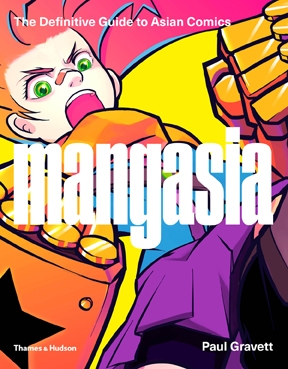Thames & Hudson, £29.95 (softcover)
If Western audiences think they know about manga, they’re probably most familiar with tropes of the Japanese form of comic art: the cute girls with big eyes and spindly legs, the bouncy, anthropomorphised animals of not-always-determinate species, the power-loaded armoured sci-fi superheroes and the extreme imaginings of monsters and physical mutability laced with fantastical sexualisation. Mangasia may not be the most elegant neologism, but it at least serves notice that there’s more to Asian comic art than this.
Mangasia is about the greater history and culture of comics art in the Asia region, which as Paul Gravett defines it, goes ‘no further west than Pakistan and no further north than Mongolia and the very top of Japan’. Gravett’s 300-page survey (it accompanies a big touring show organised by the London’s Barbican Centre and curated by the author) is ambitious, attempting to capture the historical origins of comics in cultural spheres as different as India and China. It’s a complex undertaking. Gravett divides the book into six broad thematic sections, shifting between historical, geopolitical and cultural contexts – taking in the reinvention of religious and mythological traditions, the working conditions of the manga industry and its artists, the changing face of censorship and manga’s entry into moving image and digital culture – to acknowledge how exchange with the West, colonialism, Asian nationalism, postwar rebuilding and limits on free expression have all influenced the development of this emblem of twentieth-century visual culture.
Mangasia’s most interesting aspect is the way it offers a historical narrative for how style and technique evolve in a mass-culture artform
It’s clear from the outset that though Mangasia’s intention is to offer a contemporary window onto a wider Asian geography of comics art, Japan still looms large. Japanese manga forms the largest part of the material collected, followed by Korean manhwa and Chinese manhua. This emphasis on Japan tends to highlight the conditions necessary for a vibrant comics culture to develop – a mixture of economic development and mass-cultural production, social mores and the artistic resources already available in a country’s cultural traditions. Here, Gravett makes a big play for tracing manga’s origins to the golden age of woodblock printing in the Japan of the seventeenth and eighteenth centuries, with luminaries such as Hokusai figuring as the precursors not only of high stylistic technique but also as pioneers of the mass production of images that themselves begin to perform a newly emerging role of social observation, satire and criticism.
One of Mangasia’s most interesting aspects is the way it offers a historical narrative for how style and technique evolve in a mass-culture artform. Whether Mangasia’s sample of material from different countries in Asia is truly representative is up for debate, as it’s noticeable that the works featured from the Philippines, Indonesia, India, Thailand and Taiwan tend to be limited to less recent examples; and among these, styles and techniques appear more limited, more beholden to illustrative traditions shared with Western comics and Western visual conventions of classical naturalism. The shift from a sensationalist ‘pulp’ form targeted at children and young adults, to one that allowed for more complex narrative and aesthetic innovations – the book, for example, devotes its third chapter to works that revisit the painful experiences of the Second World War and its aftermath – appears here heavily dependent on the mix of a mass market, a substantial urbanised readership and a (relatively) liberal political context. Japanese manga’s extremities – Mangasia revels in some of the more bizarre examples of Japanese manga sci-fi, pornography and pathological cuteness – comes off here as the hyperactive product of extraordinary circumstances. The artistic and stylistic forms that emerged from that have been absorbed and repurposed as the mass-cultural markets of Asia have grown and evolved, particularly in Korea, Mainland China and Hong Kong. Whether the ‘Asia’ region can sensibly extend to the Indian subcontinent seems tenuous, in both artistic and cultural terms. Nevertheless, Mangasia’s historical breadth offers a rich overview of the evolution of a distinct and vital visual culture and its origins. J.J. Charlesworth
From the Winter 2017 issue of ArtReview ArtReview Asia
